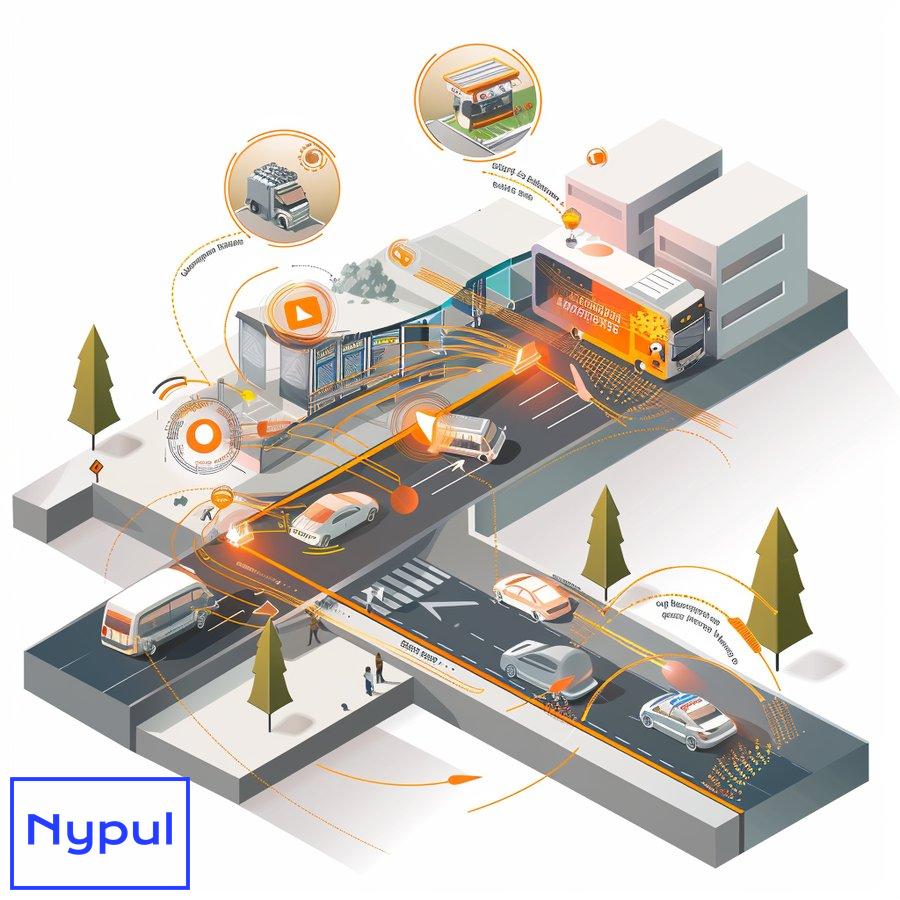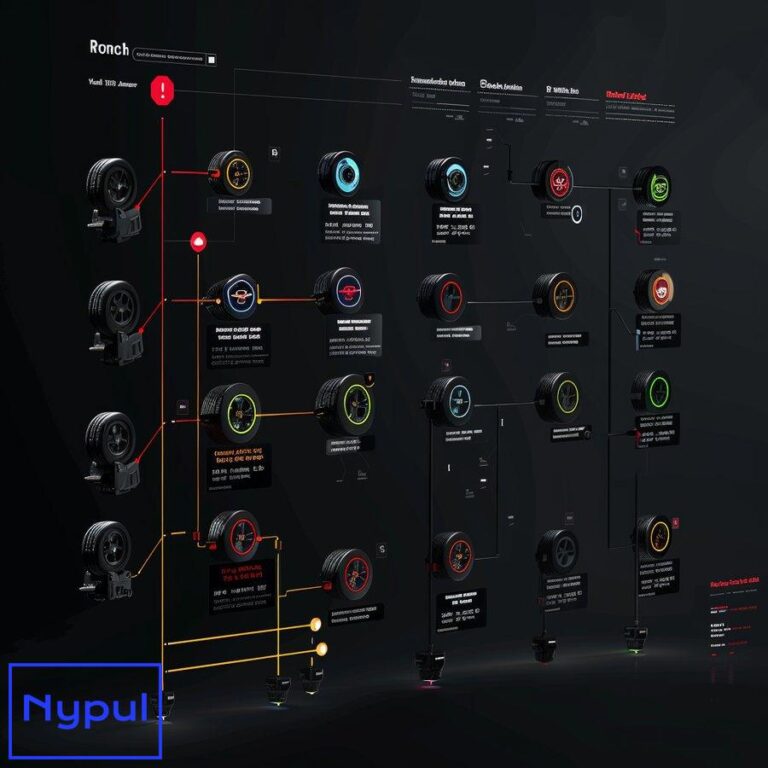How Does Advanced Emergency Braking System Work
What is an Advanced Emergency Braking System (AEBS)?
An Advanced Emergency Braking System (AEBS) is a sophisticated safety technology designed to prevent or mitigate collisions in vehicles. This intelligent system uses sensors, cameras, and radar to detect potential obstacles or hazards on the road ahead. When a potential collision is identified, AEBS automatically applies the brakes to either avoid the collision entirely or reduce its severity.
The primary goal of AEBS is to enhance road safety by providing an additional layer of protection for drivers, passengers, and other road users. This technology is particularly valuable in situations where the driver may be distracted, fatigued, or unable to react quickly enough to an emerging danger.

Key Features of AEBS
Automatic Braking: The most crucial feature of AEBS is its ability to apply the brakes without driver intervention. This automatic action can significantly reduce the impact force of a collision or prevent it altogether.
Real-time Monitoring: AEBS continuously monitors the road environment, including the distance and speed of vehicles ahead, as well as the presence of pedestrians or other obstacles.
Driver Alerts: Before engaging the brakes, many AEBS systems provide visual and auditory warnings to alert the driver of an impending collision, giving them a chance to take corrective action.
Adaptive Functionality: Advanced systems can adjust their sensitivity based on factors such as vehicle speed, road conditions, and visibility, ensuring optimal performance in various driving scenarios.
Integration with Other Safety Systems: AEBS often works in conjunction with other vehicle safety features, such as adaptive cruise control and lane departure warning systems, to provide comprehensive protection.
Types of Collisions AEBS Addresses
Rear-end Collisions: AEBS is particularly effective at preventing or mitigating rear-end collisions, which are among the most common types of vehicle accidents.
Pedestrian Collisions: Many modern AEBS systems can detect pedestrians and cyclists, helping to prevent potentially fatal accidents involving vulnerable road users.
Low-speed Collisions: In urban environments, AEBS can help avoid or reduce the impact of low-speed collisions, such as those that occur in parking lots or heavy traffic.
Benefits of AEBS
Improved Road Safety: By reducing the frequency and severity of collisions, AEBS contributes significantly to overall road safety.
Reduced Insurance Costs: Vehicles equipped with AEBS may qualify for lower insurance premiums due to their enhanced safety features.
Decreased Injury Rates: The automatic braking action of AEBS can lead to reduced injury rates for both vehicle occupants and other road users involved in collisions.
Enhanced Driver Confidence: Knowing that their vehicle is equipped with AEBS can provide drivers with increased confidence, particularly in challenging driving conditions.
Evolution of AEBS Technology
The concept of automatic braking systems has been around for several decades, with early versions appearing in the 1950s. However, these systems were primarily designed for use in trains and other rail vehicles. The development of AEBS for road vehicles began in earnest in the 1990s, with significant advancements occurring in the 21st century.
Early automotive AEBS systems were limited in their capabilities, often only able to detect large obstacles directly in front of the vehicle. As sensor technology improved and computing power increased, AEBS became more sophisticated, capable of detecting a wider range of obstacles and operating effectively at higher speeds.
Modern AEBS systems benefit from advances in artificial intelligence and machine learning, allowing them to more accurately predict potential collision scenarios and respond appropriately. These systems can now differentiate between various types of obstacles, prioritize threats, and make split-second decisions to optimize safety outcomes.
AEBS in Different Vehicle Types
While AEBS was initially developed for passenger cars, the technology has since been adapted for use in a wide range of vehicle types:
Commercial Trucks: AEBS in heavy-duty vehicles is particularly crucial due to their longer stopping distances and potential for causing severe damage in collisions.
Buses: Public transportation vehicles equipped with AEBS provide enhanced safety for passengers and other road users in urban environments.
Emergency Vehicles: Ambulances and fire trucks benefit from AEBS, helping to prevent accidents during high-speed emergency responses.
Motorcycles: Some manufacturers are developing AEBS systems specifically designed for motorcycles, addressing the unique challenges faced by two-wheeled vehicles.
Challenges in AEBS Implementation
Despite its many benefits, the widespread adoption of AEBS faces several challenges:
Cost: The advanced sensors and computing systems required for AEBS can significantly increase the cost of vehicles, particularly in lower-priced segments.
Driver Acceptance: Some drivers may be resistant to systems that can take control of their vehicle, leading to potential deactivation of AEBS features.
System Limitations: Current AEBS technology may struggle in certain conditions, such as heavy rain or snow, which can impact sensor performance.
Legal and Ethical Considerations: Questions of liability in the event of system failure or unintended activation continue to be debated by lawmakers and ethicists.
As AEBS technology continues to evolve and become more widespread, these challenges are being addressed through ongoing research, development, and regulatory efforts. The ultimate goal remains to create safer roads for all users through the intelligent application of advanced safety technologies like AEBS.
How do the components of AEBS work together?
Advanced Emergency Braking Systems (AEBS) are complex mechanisms that rely on the seamless integration of various components to function effectively. Understanding how these components work together is crucial for appreciating the sophistication of AEBS technology and its role in enhancing vehicle safety.
Sensor Suite
The sensor suite forms the foundation of any AEBS, acting as the system’s “eyes and ears.” This suite typically includes:
Radar Sensors: These emit radio waves to detect objects and measure their distance and speed. Radar sensors are particularly effective in poor visibility conditions and can operate at long ranges.
Camera Systems: High-resolution cameras provide visual information about the vehicle’s surroundings. They are crucial for object recognition and can detect lane markings, traffic signs, and pedestrians.
Lidar Sensors: Some advanced AEBS use lidar (Light Detection and Ranging) technology, which uses laser pulses to create detailed 3D maps of the environment.
Ultrasonic Sensors: These are primarily used for short-range detection, such as in parking assistance systems, but can also contribute to AEBS functionality at very low speeds.
Electronic Control Unit (ECU)
The ECU is the “brain” of the AEBS, processing the data from various sensors and making decisions based on complex algorithms. Key functions of the ECU include:
Data Fusion: Combining information from multiple sensors to create a comprehensive picture of the vehicle’s environment.
Threat Assessment: Analyzing the collected data to identify potential collision risks.
Decision Making: Determining when and how to intervene based on the assessed threat level.
System Coordination: Integrating AEBS actions with other vehicle systems, such as stability control and airbag deployment.
Braking System
The braking system is the “muscle” of the AEBS, responsible for executing the ECU’s commands to slow or stop the vehicle. Components include:
Brake Actuators: These devices apply force to the brake pads or shoes when activated by the ECU.
Anti-lock Braking System (ABS): Works in conjunction with AEBS to prevent wheel lock-up during emergency braking.
Electronic Stability Control (ESC): Helps maintain vehicle control during sudden braking or steering maneuvers.
Human-Machine Interface (HMI)
The HMI is the point of interaction between the AEBS and the driver, providing:
Warning Indicators: Visual and auditory alerts to inform the driver of potential collision risks.
System Status Display: Information about the operational status of the AEBS.
Control Interface: Allows the driver to adjust system settings or deactivate the AEBS if necessary.
Communication Systems
Modern AEBS may incorporate vehicle-to-vehicle (V2V) or vehicle-to-infrastructure (V2I) communication capabilities, enhancing their ability to detect and respond to potential hazards.
Integration Process
The integration of these components involves several key processes:
Sensor Data Collection
Each sensor in the AEBS suite continuously collects data about the vehicle’s environment. This includes:
Object Detection: Identifying vehicles, pedestrians, and other obstacles in the path of the vehicle.
Distance Measurement: Calculating the distance to detected objects.
Relative Speed Calculation: Determining the speed of the vehicle relative to other objects.
Environmental Conditions: Assessing factors such as road surface conditions and visibility.
Data Processing and Fusion
The ECU receives raw data from all sensors and processes it to create a comprehensive understanding of the vehicle’s surroundings:
Sensor Fusion Algorithms: Combine data from multiple sensors to create a more accurate and reliable picture of the environment.
Filtering and Noise Reduction: Remove irrelevant data and reduce sensor noise to improve accuracy.
Object Classification: Categorize detected objects (e.g., cars, trucks, pedestrians) to determine appropriate response strategies.
Threat Assessment
Using the processed sensor data, the ECU performs continuous threat assessment:
Collision Prediction: Calculate the likelihood of a collision based on the trajectory and speed of the vehicle and detected objects.
Time-to-Collision (TTC) Estimation: Determine how much time remains before a potential impact.
Risk Prioritization: Assess multiple potential threats and prioritize the most immediate dangers.
Decision Making
Based on the threat assessment, the ECU determines the appropriate course of action:
Warning Activation: Decide when to issue driver warnings through the HMI.
Brake Preparation: Pre-charge the braking system to reduce response time if emergency braking becomes necessary.
Brake Application: Determine the timing and intensity of automatic brake application.
System Activation
When the ECU decides that intervention is necessary, it initiates the following actions:
Driver Warning: Activate visual and auditory alerts through the HMI.
Brake Activation: Send signals to the brake actuators to apply the appropriate braking force.
ABS and ESC Coordination: Ensure that braking is applied in a controlled manner to maintain vehicle stability.
Continuous Monitoring and Adjustment
Throughout the entire process, the AEBS continuously monitors the situation and adjusts its actions:
Real-time Feedback: Constantly update threat assessments based on new sensor data.
Brake Force Modulation: Adjust braking intensity based on changes in the environment or driver input.
System Deactivation: Cease intervention if the threat passes or the driver takes control.
Table: AEBS Component Interaction
| Component | Primary Function | Interaction with Other Components |
|---|---|---|
| Sensors | Data collection | Provides raw data to ECU |
| ECU | Data processing and decision making | Receives data from sensors, sends commands to braking system and HMI |
| Braking System | Executes braking commands | Receives activation signals from ECU, coordinates with ABS and ESC |
| HMI | Driver communication | Receives warning signals from ECU, provides system status information |
| Communication Systems | External data exchange | Shares and receives data with other vehicles and infrastructure |
The seamless integration of these components allows AEBS to rapidly detect potential collision risks, warn the driver, and take autonomous action when necessary. This complex interplay of technologies represents a significant advancement in vehicle safety systems, contributing to the reduction of accidents and the severity of collisions when they do occur.
As AEBS technology continues to evolve, we can expect to see even greater integration of components, improved sensor capabilities, and more sophisticated decision-making algorithms. These advancements will further enhance the effectiveness of AEBS in protecting vehicle occupants and other road users.
What are the steps in the AEBS collision prevention process?
The Advanced Emergency Braking System (AEBS) follows a structured process to prevent collisions or mitigate their severity. This process involves several critical steps, each designed to assess the situation, alert the driver, and take appropriate action when necessary. Understanding these steps provides insight into the sophisticated nature of AEBS and its role in enhancing road safety.

Continuous Monitoring
The first and ongoing step in the AEBS collision prevention process is continuous monitoring of the vehicle’s environment. This involves:
Sensor Data Collection: The various sensors (radar, cameras, lidar, etc.) constantly gather information about the vehicle’s surroundings.
Data Processing: The Electronic Control Unit (ECU) processes the raw sensor data, applying filtering algorithms to reduce noise and improve accuracy.
Environmental Mapping: The system creates a real-time map of the vehicle’s environment, including the position and movement of other vehicles, pedestrians, and obstacles.
Threat Detection
Once the environment is mapped, the AEBS moves to identify potential threats:
Object Classification: The system categorizes detected objects (e.g., cars, trucks, pedestrians, cyclists) to determine their relevance to collision risk.
Trajectory Prediction: Based on the current speed and direction of both the vehicle and detected objects, the system predicts their future positions.
Risk Assessment: The AEBS evaluates the likelihood of a collision by considering factors such as closing speed, distance, and predicted trajectories.
Driver Alert
If a potential collision risk is identified, the system initiates driver alerts:
Visual Warnings: Dashboard lights or heads-up display indicators may illuminate to draw the driver’s attention to the potential danger.
Auditory Alerts: Warning sounds or voice prompts may be activated to alert the driver of the impending risk.
Haptic Feedback: Some systems may use steering wheel vibration or seat vibration to provide a tactile warning to the driver.
Brake Preparation
Simultaneously with driver alerts, the AEBS begins preparing the braking system:
Brake Priming: The system increases hydraulic pressure in the braking system to reduce the time required for full brake application.
Brake Assist Readiness: The Brake Assist system is prepared to provide maximum braking force if the driver responds to the warnings.
Driver Response Monitoring
The AEBS monitors the driver’s response to the warnings:
Steering Input: The system detects any steering actions that might indicate the driver is attempting to avoid the obstacle.
Brake Pedal Pressure: Any application of the brake pedal by the driver is monitored to assess if sufficient braking force is being applied.
Accelerator Release: The system checks if the driver has released the accelerator pedal in response to the warnings.
Autonomous Braking Decision
If the driver does not respond adequately to the warnings, or if a collision becomes imminent, the AEBS makes a decision on autonomous intervention:
Time-to-Collision (TTC) Calculation: The system continuously updates its calculation of the time remaining before a potential impact.
Intervention Threshold: Based on the TTC and other factors, the AEBS determines if and when autonomous braking should be initiated.
Braking Force Calculation: The system computes the necessary braking force required to avoid the collision or minimize its impact.
Brake Application
When the decision for autonomous intervention is made, the AEBS applies the brakes:
Initial Brake Application: The system begins applying brake pressure, often starting with moderate force.
Progressive Braking: If the collision risk persists, the braking force is progressively increased.
Maximum Braking: In critical situations, the system may apply full braking force to maximize the chance of avoiding the collision.
Stability Control Integration
During brake application, the AEBS works in conjunction with other vehicle safety systems:
Anti-lock Braking System (ABS): Prevents wheel lock-up during hard braking to maintain steering control.
Electronic Stability Control (ESC): Helps maintain vehicle stability during sudden braking or evasive maneuvers.
Collision Mitigation
If a collision cannot be completely avoided, the AEBS focuses on mitigation:
Impact Speed Reduction: By applying maximum braking force, the system aims to reduce the vehicle’s speed as much as possible before impact.
Occupant Protection Systems: The AEBS may trigger the pre-tensioning of seatbelts and prepare airbag systems for potential deployment.
Post-Collision Actions
After a collision occurs or is successfully avoided, the AEBS may take additional actions:
Brake Hold: Some systems maintain brake pressure for a short period after stopping to prevent the vehicle from rolling.
Hazard Light Activation: Automatic activation of hazard lights to alert other road users of the incident.
Emergency Services Notification: In vehicles equipped with automatic crash notification systems, emergency services may be alerted.
System Reset and Data Logging
The final step in the process involves resetting the system and recording event data:
System Check: The AEBS performs a self-check to ensure all components are functioning correctly after the event.
Data Recording: Information about the incident, including sensor data and system actions, is logged for later analysis and potential legal purposes.
System Reset: The AEBS resets itself to be ready for future potential incidents.
Table: AEBS Collision Prevention Process Steps
| Step | Primary Action | Time Frame | System Components Involved |
|---|---|---|---|
| Continuous Monitoring | Environment scanning | Ongoing | Sensors, ECU |
| Threat Detection | Step | Primary Action | Time Frame |
| —— | —————- | ———— | —————————- |
| Continuous Monitoring | Environment scanning | Ongoing | Sensors, ECU |
| Threat Detection | Identifying potential collision risks | Milliseconds | ECU, Sensors |
| Driver Alert | Notifying the driver of risks | Milliseconds to seconds | HMI, ECU |
| Brake Preparation | Priming the braking system | Milliseconds to seconds | Braking System, ECU |
| Driver Response Monitoring | Assessing driver actions | Milliseconds to seconds | ECU, HMI |
| Autonomous Braking Decision | Deciding on intervention | Milliseconds to seconds | ECU |
| Brake Application | Engaging the brakes autonomously | Milliseconds to seconds | Braking System, ECU |
| Stability Control Integration | Coordinating with other safety systems | Milliseconds to seconds | ABS, ESC |
| Collision Mitigation | Reducing impact severity if collision occurs | Instantaneous upon impact decision | Braking System |
| Post-Collision Actions | Taking actions after a collision event | Immediate after collision or avoidance | ECU, HMI |
| System Reset and Data Logging | Preparing for future incidents and recording data | Immediately after incident resolution | ECU |
Through these steps, AEBS effectively enhances vehicle safety by continuously monitoring the environment, assessing threats, alerting drivers, and intervening when necessary. The integration of various components ensures that the system can respond rapidly and effectively to potential collisions, thereby reducing the likelihood of accidents and their associated consequences.
Which types of AEBS are currently available?
The Advanced Emergency Braking System (AEBS) has evolved significantly since its inception, leading to a variety of systems tailored for different vehicle types and driving conditions. Understanding the available types of AEBS can help consumers make informed decisions when purchasing vehicles equipped with this technology.
1. Basic AEBS
Basic AEBS is designed primarily for low-speed applications. It typically functions in urban environments where the risk of rear-end collisions is higher. Key characteristics include:
-
Speed Range: Operates effectively at speeds below 30 km/h (approximately 18.6 mph).
-
Functionality: Primarily focuses on detecting stationary or slow-moving vehicles directly in front.
-
Driver Alerts: Provides warnings but may not engage automatic braking.
2. Standard AEBS
Standard AEBS offers enhanced capabilities compared to basic systems. This version is commonly found in many modern passenger vehicles. Features include:
-
Speed Range: Operates effectively at speeds up to 80 km/h (approximately 49.5 mph).
-
Functionality: Detects both stationary and moving vehicles, as well as pedestrians in certain conditions.
-
Automatic Braking: Engages automatic braking when a collision risk is detected.
3. Advanced AEBS
Advanced AEBS represents the latest generation of emergency braking systems, incorporating cutting-edge technology for improved performance. Key features include:
-
Speed Range: Operates effectively across a wide speed range, from low speeds up to highway speeds (over 100 km/h or 62 mph).
-
Functionality: Capable of detecting a broader range of obstacles, including pedestrians, cyclists, and animals.
-
Adaptive Functionality: Adjusts sensitivity based on driving conditions and vehicle speed.
-
Integration with Other Systems: Works in conjunction with adaptive cruise control and lane-keeping assistance for comprehensive safety.
4. Commercial Vehicle AEBS
Commercial vehicles such as trucks and buses require specialized AEBS due to their size and weight. These systems are designed to address specific challenges faced by larger vehicles:
-
Longer Stopping Distances: Takes into account the longer stopping distances required for heavy vehicles.
-
Enhanced Detection Capabilities: Incorporates additional sensors to monitor blind spots and detect obstacles in complex environments.
-
Collision Mitigation Features: Often includes features that help mitigate collisions with other large vehicles or stationary objects.
5. Motorcycle AEBS
Motorcycles present unique challenges for collision avoidance due to their smaller size and maneuverability. Motorcycle AEBS is being developed with specific features:
-
Obstacle Detection: Focuses on detecting larger vehicles and potential hazards in the rider’s path.
-
Real-time Feedback: Provides immediate alerts to riders about potential dangers.
-
Integration with Stability Control Systems: Works alongside existing motorcycle stability control systems for enhanced safety.
Table: Types of AEBS Overview
| Type of AEBS | Speed Range | Key Features |
|---|---|---|
| Basic AEBS | <30 km/h | Low-speed functionality; mainly alerts |
| Standard AEBS | Up to 80 km/h | Automatic braking; detects moving vehicles |
| Advanced AEBS | Up to 100 km/h+ | Broad obstacle detection; adaptive functionality |
| Commercial Vehicle AEBS | Varies by vehicle size | Longer stopping distances; enhanced detection |
| Motorcycle AEBS | Varies | Focused on larger vehicle detection; real-time alerts |
Each type of AEBS plays a crucial role in enhancing road safety across different vehicle categories and driving scenarios. As technology continues to advance, we can expect further improvements in these systems’ capabilities and effectiveness.
How effective is AEBS in reducing collisions?
The effectiveness of Advanced Emergency Braking Systems (AEBS) in reducing collisions has been a subject of extensive research and analysis. Numerous studies have demonstrated that these systems significantly enhance vehicle safety by preventing accidents or mitigating their severity.
Statistical Evidence
Research indicates that vehicles equipped with AEBS experience a notable reduction in collision rates:
-
Rear-end Collisions: Studies show that AEBS can reduce rear-end collisions by approximately 40% to 50%. This statistic highlights the system’s effectiveness in preventing one of the most common types of accidents on the road.
-
Pedestrian Accidents: In urban environments where pedestrian traffic is high, AEBS has been shown to reduce pedestrian-related accidents by up to 30%. This is particularly important given the increasing focus on pedestrian safety in city planning.
-
Overall Crash Reduction: A comprehensive analysis conducted by various automotive safety organizations has found that vehicles equipped with advanced safety technologies like AEBS can reduce overall crash rates by about 20% to 30%.
Real-world Case Studies
Several real-world case studies have further illustrated the effectiveness of AEBS:
-
A study conducted by the Insurance Institute for Highway Safety (IIHS) found that cars equipped with forward-collision warning systems combined with automatic emergency braking had significantly lower crash rates compared to those without such technologies.
-
In Europe, an evaluation of commercial trucks fitted with AEBS showed a marked decrease in serious accidents involving heavy vehicles. The European Commission reported a reduction in fatalities among truck drivers and other road users due to enhanced braking capabilities.
Limitations in Effectiveness
While the effectiveness of AEBS is well-documented, there are limitations that can affect performance:
-
Environmental Conditions: Adverse weather conditions such as heavy rain or snow can impact sensor performance, potentially reducing the system’s effectiveness.
-
Complex Traffic Scenarios: In situations involving multiple moving objects or unpredictable driver behavior (e.g., sudden lane changes), AEBS may struggle to react appropriately.
-
Driver Behavior Influence: The overall effectiveness of AEBS can be influenced by driver behavior. If drivers are not attentive or fail to heed warnings from the system, the benefits may be diminished.
Despite these limitations, it is clear that when functioning optimally, AEBS plays a crucial role in enhancing road safety and reducing collision rates across various scenarios.
What are the limitations of current AEBS technology?
While Advanced Emergency Braking Systems (AEBS) represent a significant advancement in automotive safety technology, they are not without limitations. Understanding these limitations is essential for both manufacturers and consumers as they navigate the evolving landscape of vehicle safety features.
1. Sensor Limitations
The sensors used in AEBS play a critical role in detecting obstacles and assessing risks. However, they have inherent limitations:
-
Environmental Sensitivity: Weather conditions such as rain, fog, snow, or ice can obstruct sensor functionality. For example, radar sensors may struggle with heavy precipitation that affects signal clarity.
-
Field of View Restrictions: Some sensors may have limited fields of view or blind spots that could allow obstacles to go undetected if they fall outside their operational range.
-
Object Classification Challenges: Differentiating between various types of obstacles (e.g., pedestrians vs. large animals) can be difficult for current sensor technologies, potentially leading to inappropriate responses.
2. Performance Variability
The performance of AEBS can vary significantly based on several factors:
-
Speed Sensitivity: While many systems function well at lower speeds (e.g., urban driving), their effectiveness may diminish at higher speeds where reaction times are critical.
-
Traffic Complexity: In complex traffic situations involving multiple moving objects or erratic driver behavior (such as sudden lane changes), AEBS may struggle to make accurate assessments quickly enough.
-
System Calibration Issues: Variability in system calibration between different manufacturers can lead to inconsistencies in performance across vehicle models equipped with similar technologies.
3. Driver Interaction Challenges
The interaction between drivers and AEBS systems presents additional challenges:
-
Overreliance on Technology: Drivers may become overly reliant on AEBS technology, leading them to pay less attention to their surroundings or neglect basic defensive driving practices.
-
False Alerts and Deactivation Risks: Frequent false alerts from the system can lead drivers to disable or ignore warnings over time, reducing overall system effectiveness during critical moments.
-
Driver Response Time Variability: The speed at which drivers respond to alerts from the system varies among individuals; some may react promptly while others may delay their response due to distraction or surprise.
How is AEBS regulated in different regions?
Regulation plays a crucial role in ensuring that Advanced Emergency Braking Systems (AEBS) meet safety standards across various regions worldwide. Different countries have established regulations governing the design, testing, and implementation of these systems based on local road safety needs and technological advancements.
North America
In North America, particularly within the United States:

-
The National Highway Traffic Safety Administration (NHTSA) oversees regulations related to vehicle safety standards.
-
While there are currently no mandatory requirements specifically for AEBS installation in passenger vehicles, NHTSA encourages manufacturers to include advanced safety technologies through voluntary guidelines.
-
The agency has initiated research programs aimed at understanding the benefits and effectiveness of various advanced driver assistance systems (ADAS), including AEBS.
Europe
Europe has taken a more proactive approach regarding vehicle safety regulations:
-
The European Union has established strict regulations mandating certain advanced safety features in new vehicles.
-
As part of its General Safety Regulation (GSR), EU legislation requires all new passenger cars and light commercial vehicles sold after July 2022 to be equipped with an advanced emergency braking system.
-
The European Commission conducts regular evaluations of existing regulations based on technological advancements and accident data trends.
Asia-Pacific
Countries within Asia-Pacific also exhibit varying regulatory approaches toward AEBS:
-
Japan has implemented its own set of standards through organizations like JASIC (Japan Automotive Standards Internationalization Center), promoting advanced safety technologies among domestic manufacturers.
-
In Australia, similar regulations are evolving under the Australian Design Rules (ADRs), which aim at enhancing vehicle safety through improved standards for electronic stability control and other ADAS technologies.
Global Harmonization Efforts
Recognizing the importance of global harmonization for vehicle safety standards:
-
Organizations like the United Nations Economic Commission for Europe (UNECE) work towards creating internationally accepted regulations for advanced driver assistance systems.
-
The UNECE’s WP.29 group focuses on developing uniform technical prescriptions for automated driving systems globally.
Future Regulatory Trends
As technology continues evolving rapidly:
-
Regulatory bodies worldwide are likely to adapt existing frameworks or create new ones addressing emerging challenges associated with autonomous driving technologies.
-
There will be an increased emphasis on real-world testing data collection regarding how effective these systems are under various driving conditions globally.
Understanding regional regulations surrounding AEBS helps consumers make informed choices about vehicle safety features while encouraging manufacturers toward innovation aligned with public safety goals.
What maintenance does AEBS require?

Maintaining an Advanced Emergency Braking System (AEBS) is essential for ensuring its optimal performance throughout a vehicle’s lifespan. Regular maintenance practices help prevent malfunctions that could compromise road safety. Below are key aspects related to maintaining an effective AEBS:
Regular System Checks
Routine inspections should be performed periodically as part of standard vehicle maintenance:
- Sensor Calibration
- Ensure sensors are properly calibrated according to manufacturer specifications.
-
Misaligned sensors can lead to inaccurate readings or failure to detect obstacles effectively.
-
Diagnostic Testing
- Utilize onboard diagnostic tools during service appointments to check for error codes related to the braking system.
-
Address any identified issues promptly before they escalate into significant problems.
-
Software Updates
- Manufacturers often release software updates aimed at improving system performance or addressing known issues.
- Keeping software updated ensures that your vehicle benefits from enhancements made since its original release.
Physical Inspection
In addition to electronic checks:
- Sensor Cleanliness
- Regularly clean sensors (radar units/cameras) from dirt or debris that could obstruct their functionality.
-
Ensure no physical obstructions exist around sensors that might impede their field of view.
-
Brake System Maintenance
- Inspect brake pads/shoes regularly since worn components could affect overall braking performance.
- Check hydraulic fluid levels; low fluid levels might hinder brake response times.
Driver Awareness
Drivers play an essential role in maintaining effective operation:
- Monitoring Alerts
-
Pay attention when warning signals activate; they could indicate malfunctions requiring immediate attention.
-
Understanding Limitations
- Familiarize yourself with how your specific model’s AEB functions under various conditions—knowing its strengths/weaknesses aids proactive maintenance.
Professional Servicing
Engaging qualified professionals ensures comprehensive care:
- Certified Technicians
-
Have trained technicians perform routine maintenance checks specifically targeting advanced driver assistance systems like AEB.
-
Manufacturer Recommendations
- Follow guidelines provided by manufacturers regarding maintenance schedules tailored explicitly for your vehicle model.
Conclusion
In summary:
Maintaining an Advanced Emergency Braking System involves regular checks on both electronic components like sensors/software updates along with physical inspections focusing on cleanliness/wear-and-tear aspects related directly back towards brake performance itself—all while staying aware as drivers about how best utilize this life-saving technology effectively!
By adhering diligently towards these practices ensures continued reliability from your AEB throughout its operational life—ultimately contributing positively towards safer roads overall!




